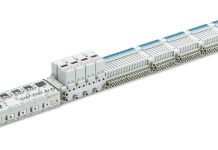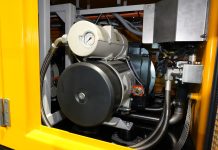Camozzi Automation has developed a new range of valves, called “Series D”, for applications with narrow installation space, where it is necessary to have control elements close to the actuator. These products mainly stand out for the sturdiness of the valve body, made of aluminium, and various design choices aimed at guaranteeing utmost reliability even in harsh operating conditions. The new Series D is more properly a new family of solenoid valves, made up by different sizes, from 10.5 mm to 25 mm, including the intermediate 16 mm size. Flow rates correspondently change from 300 Nl/min. to 2000 Nl/min.
Proprietary electronics
However, the real innovative feature resides in the integration into the head module and single sub-bases, in valve island versions, of proprietary electronics that allows monitoring the operation and the health state of valves. This approach makes our new Series D rank in the array of smart components, i.e. devices able to carry out their condition assessment. The architecture of a smart component is based on the integration of performance measuring sensors and of processing electronics into the component itself, together with a data transmission system, for the communication with machine and system (or with cloud). The health monitoring system is embedded, with edge processing typology: through two patented solutions, merged into Camozzi CoilVision technology, data are processed inside the valve itself; it is not a statistical processing, based on the comparison with previous measurements, but the constant control of operation parameters of solenoid valves in their interior.
Constant monitoring
The CoilVision technology has been developed to monitor constantly the functional parameters of the solenoid that drives the spool. Each operation of the solenoid, in different cyclic configurations and environmental conditions, is analysed to collect information that, processed by software algorithms, allow diagnosing and forecasting the health state of the component. Besides the heath state, the condition (ON/OFF) of each valve, the temperature of the master module and of solenoids inside valves are detected; besides, conditions of short circuit or anomalous absorption, over- and under- voltage and solenoid interruption are diagnosed; finally, a counter of the number of cycles (commutations) of solenoid valves and an electric consumption indicator are available. Therefore, the new Series D becomes a precious tool for integrators and OEM looking for Industry 4.0 – compliant components. Processed and refined data are in fact transmitted by the valve island to outside, through a proprietary WLAN protocol as well as on fieldbuses (Profinet, CANOpen, Profibus, Ethernet/IP etc.); in the course of 2020, the release of an IO-Link version is scheduled, too.

Downloadable software
As support of the model equipped with WLAN module, Camozzi has made available free of charge on its site the UVIX (Universal Visual Interface) software, i.e. a web-based graphic interface that dialogues with components and shows their fundamental data. UVIX can be downloaded from Camozzi site (http://catalogue.camozzi.com/Downloads.aspx?cat=205) in the version for Windows (7, 8 or 10) and it can be installed with a guided procedure. As alternative to Windows, it is possible to use the free Ubuntu 16.04 or 18.04 system, turning to Camozzi Service for installation packages and related procedure. Being a web-based app, once installed on a PC or on a gateway, it can be questioned by other PC, tablets and smartphones, using one’s own preferred browser. The new series D acts then as a “sensor node” of an IIoT system, which can be composed by the customer (integrator or OEM) either by using its own gateway or PC or demanding for the supply to Camozzi. Data strings use a MQTT format, therefore the customer can decide to make data converge towards its own platform, historicizing and saving data when necessary. MQTT, acronym of Message Queuing Telemetry Transport, is today one of the most diffused protocols in various applicative ambits, due to its lightness (fundamental feature when the available band is limited) and user-friendly implementation. MQTT works with publish-subscribe methods, conforms to ISO standards, allows low-consumption implementations and efficient distribution of data through the minimized package system.

Camozzi Digital
A further alternative, for customers that do not rely on their IIoT platform, is availing themselves of Camozzi Digital’s support for the use of storage cloud solutions, data visualization and analysis. In that case, there is the availability of dashboards that can be composed with the data of interest ad synthetic graphic indicators of the main parameters of components. A dashboard is a data management tool that allows tracing KPIs, metrics, setting up charts of the relevant data for a work, a department and a specific process. By using info-graphics, dashboards simplify wholes of complex data, to provide users with the awareness of current performances in a trice.
Flexible service
Inside the family of the new Series D, Camozzi will offer its products with the highest configuration flexibility, then it will be possible to achieve for instance a valve island that dialogues through fieldbuses with the PLC, to receive its controls, and at the same time it sends through a WLAN module the diagnostic data to an IIoT gateway, or to have the same data integrated into the packages that travel on fieldbuses, without needing an auxiliary wireless system. Constant listening to its customers has in fact shown various requirements and approaches to the Industry 4.0 theme and Camozzi intends to act as open-minded collaborative partner for customers, leaving them flexibility in the architectural definition of their applications. In the Industrial Internet of Things ambit, one of the main challenges, still unaccomplished owing to the shortage of a univocal standard, is interoperability: both industrial and IoT protocols are manifold, conceived as solution to specific use cases. The domain knowledge of the automation field has allowed Camozzi to make targeted choices for the sector itself, however turning to those technologies and protocols that favour user-friendliness and integration. The same attention is paid to enabling technologies, then their family will be soon provided with a multi-serial module with NFC interface, useful in configuration, installation and service phase, to draw in contactless modality some data such as product serial number, specific setups and precisely configuration.



